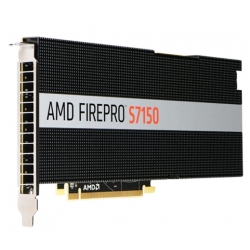Now we all know that NVIDIA has their GIRD computing platform which allows them to serve up high-performance cloud gaming as well as GPGPU workloads using OpenCL or Cuda applications using current NVIDIA GPUs. The question is, does this use case equal hardware virtualization of the GPU? AMD seems to think that it does not, hence the “world’s first” claim. The GRID platform is also not something you can run on your own, so while NVIDIA has a virtualized GPU platform, it does not have a product for the masses.
So, what makes the AMD solution different? Well for starters it was designed from the ground up to be a virtualized solution and it also incorporates features that are platform independent (to a certain degree). AMD is building this around an existing standard (SR-IOV or Single Root I/O Virtualization). As you might have guessed SR-IOV is a method of taking a single hardware resource and virtualizing the IO streams to the guest layer. There has been a limited for of this for many desktop virtualization applications including DirectX support in VMware Workstation. The problem comes when you start pushing out multiple workstations that need high-end graphics support. Here there has been nothing to help out. In the case of CAD or other GPU assisted imaging platforms you need to buy expensive workstations to cover the work load.
AMD’s solution can take care of that in addition to adding in a healthy layer of security by using hardware enforced memory isolation between VMs. The cost savings that stems from using something like this can be significant. For the 8GB GDDR5 sporting FirePro S7150 you can get up to 16 simultaneous users running on the same GPU (using VDI etc.). On the S7150 X2 (16GB GDDR5, 8GB per GPU) you can push up to 32 users (again simultaneous). Unfortunately the press release did not say what type of workload scaling this figure is so the real-world number of users might be much lower depending on what application you are pushing.
The 7150 line also appears to be a very open card with functions accessible to the virtualization layer including DirectX, OpenCL, OpenGL and more. Companies like VMware will still need to utilize the right drivers to unlock these functions, but we are sure that AMD will have these ready by the time they launch this year. The technology behind this is matching up with VMware’s VDI solution Horizon right now. This means that you will not see this running on your standard ESXi server in aq vSphere environment. Horizon is comparable to Citrix’s XennDesktop solution so we might see the S7150s supporting that side of the house as well. If VMware does get this as an exclusive it will certainly have an impact on Citrix as an app delivery leader.
We will be sure to keep an eye on this one as they get closer to launch and more partners hit the scene. For now this looks to be a solid product on the part of AMD although it is certainly for enterprise class systems and will also only be sold to OEMs at launch.
See the press release




